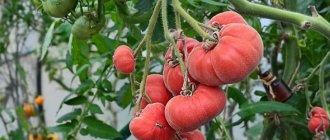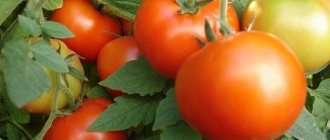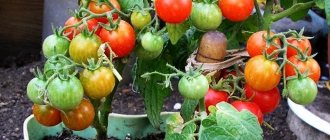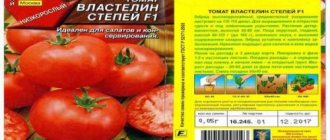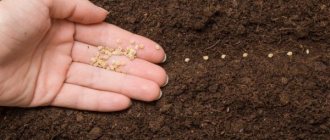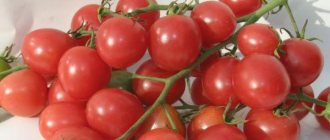Description
The Babushkino tomato is an indeterminate variety and can reach 1.7-1.9 m in height. Since it is not a hybrid, its flowers require pollination, and in greenhouse conditions they are most often pollinated by hand if pollinating insects cannot be attracted there .
According to the ripening period, the Babushkino tomato is classified as mid-early - from the moment of germination of the seed material to the harvesting of ripe large tomatoes, a little less than 4 months pass.
Among large-fruited tomatoes, it is also worth considering the variety Puzata Khata
Due to the fact that strong and strong shoots can reach a height of 2.0 m, they have to be tied in several places to strong supports. Experienced vegetable growers recommend using trellises for this. In addition, it is necessary to tie up the clusters with large fruits, otherwise they may break off under the weight of such a weight.
For better fruiting, it is recommended to grow these bushes in 2 or 3 shoots - in these cases the fruits will be larger. If you leave most of the stepsons on the bushes, then the fruits will grow small - no more than 100-150 g.
The stems are well leafy. The foliage has a classic tomato shape, medium in size, with slightly elongated sharp tips. Its color is deep green.
Related article:
Why do tomato leaves curl?
Small flowers are collected in racemose inflorescences, in each of which up to 4 ovaries are formed. Their shape is rounded and flattened, the ribbing is weak. When the bushes are formed and the bushes are well cared for, you can collect fruits weighing 1.0 kg, but more often these tomatoes ripen tomatoes weighing about 250-350 g.
The skin is compacted, less than medium in size, and cannot be particularly felt when eating. Its color is pink with a red tint; when ripe, there is usually no green spot left near the stalk, but a yellow spot may remain.
The pulp is quite compacted, with a sufficient amount of juice, its color is pink. The number of seed chambers is from 2 to 5; there is not too much seed material in them. The taste of ripe fruits is not bad; the fruits perfectly combine sourness and light sweetness. They also have a very pleasant aroma.
Unfortunately, these large fruits do not tolerate transportation well, as their skin is prone to cracking. Therefore, during transportation, tomatoes may leak and lose their attractive appearance.
And the shelf life of the harvested crop is not too high - it is better to use them for food or for preparations as soon as possible after harvesting.
Babushkino tomatoes on video
The variety is very productive, requiring fertilizing with complex fertilizers during the growing season.
This is a natural variety of tomato. Therefore, we recommend taking seeds from a ripe fruit and using them for planting in subsequent seasons.
If you grew Babushkino tomatoes, please write whether you liked them or not. What was the yield and taste of the fruit under your conditions? How do you rate the disease resistance of this variety? If possible, attach a photo of the entire bush or individual fruits you grew to your comment. Thank you!
If you are interested in other varieties of tomatoes from collectors, we recommend that you look at the Catalog of tomato varieties with photos and descriptions from private producers.
Main characteristics
Babushkino tomato bushes are resistant to sudden changes in climatic conditions and temperature fluctuations.
Productivity
Since this variety is large-fruited, the yield of the Babushkino tomato is very high - up to 5 kg of large fruits are harvested from each bush over the summer, and at least 20-22 kg from each square.
Related article:
To make tomatoes turn red quickly
Area of application of fruits
Tomatoes of this variety have a pleasant taste, so they are used fresh for food, and they are also used to make various twists - lecho, paste, as well as juice with an unusual pinkish color, as well as other winter snacks.
Diseases and pests
The Babushkino tomato has high resistance to most viruses and fungal diseases.
If the bushes of this tomato are attacked by pests, then the fight against them should be started immediately, then the harmful insects will not bring any harm to this vegetable plant.
Tomato diseases and measures to combat them
Reviews about this variety
The description of the Babushkino tomato variety and reviews about it make it possible to evaluate this variety and its advantages. Basically, summer residents emphasize the positive aspects of tomatoes. Among the advantages, it can be noted that the harvest is rich, they are resistant to diseases, and are stored well. A distinctive feature of these tomatoes is that they love very good soil and need to be fed frequently. It is because of this that Babushkino will not bear the required amount of fruit everywhere.
This variety is susceptible to diseases precisely due to lack of nutrition . Does not tolerate transportation well and may crack on the skin. However, if someone once managed to harvest a bountiful harvest of fragrant fruits, they want to plant it again in the following years.
This variety can be grown by anyone in the garden, even a beginner. Caring for it is not difficult, but if you want to get more juicy sweet fruits, then you should pay attention to them daily.
Advantages
Of the main advantages of the Babushkino tomato, experienced vegetable growers note:
- large fruit;
- good taste and appearance of the fruit;
- high yield;
- resistance to most pathogenic infections;
- resistance to stressful situations and sudden temperature fluctuations.
Grandma's Happiness
The line continues with the Babushkino Shchastie variety. It appeared among gardeners in 2012. The originator is Moscow. The tomato is mid-season, indeterminate. It is recommended for all regions, for greenhouses and for unprotected soil:
| № | Helpful information |
| 1 | The Babushkino Shchastya tomato is distinguished by pink watermelon pulp. The tomato is very aromatic and sweet, without sourness |
| 2 | large-fruited variety. A marketable weight is considered to be 270 g. From the practice of private growers, the weight of a tomato can reach 800 g. Most fruits on a bush weigh 370 g |
| 3 | yield according to the originator 18.1 kg/m2 |
The first brush grows under the 9th leaf. Up to 8 ovaries can form on a peduncle, but the most effective fruits are left. The remaining ovary is removed to grow large tomatoes. It is recommended to install supports under the brush or adapt a mesh that is fixed to the trellis.
Flaws
Among the disadvantages of tomato it should be noted:
- it is very difficult to find high-quality seed material on sale;
- ripe tomatoes are prone to cracking, and larger fruits have larger cracks, and their presentation deteriorates as a result;
- fruits do not tolerate transportation well, during which they lose some of their valuable qualities. As a result, such a product is more difficult to sell;
- ripe fruits are not suitable for whole-fruit canning;
- To get a good harvest of large fruits, fertilizing should be done in a timely manner.
A selection of reviews from amateur gardeners
Among the reviews on thematic forums there are both positive and negative. In general, those who carefully looked after the garden bed had a positive experience. A tomato will not grow without attention. Valentina Redko from Kurgan received fruits larger than the palm of her hand and weighing up to 700 g. There were 12 pieces on one hand. A woman privately distributes seed material throughout the Russian Federation.
Natalya from Chernigov shared her experience of growing tomatoes in a greenhouse on a warm bed. The bushes produced equally large fruits from mid-July until cold weather. Anna-Valentina from Rostov region. notes the resistance of the variety to late blight. We have already written about other varieties resistant to this disease here.
And although this tomato is not included in the State Register, many gardeners grow and praise it. The successful practice of obtaining decent harvests has been proven in both warm and northern regions.
Nuances of planting and growing
This tomato variety is grown using the seedling method. Seed material should be planted for seedlings in the second ten days of March, and transplanted to a permanent place after 55-60 days.
Seedling planting schedule: planting calendar for 2022 for gardeners and gardeners
Prepare the soil in advance for planting seeds if it will be prepared at home. To do this, mix peat, garden soil, river sand and humus. A complex of minerals – superphosphate, potassium sulfate, urea – should also be added to the resulting substrate.
Related article:
Tomato leaves turn yellow in greenhouses and open ground: what to do?
The seed material is laid out on the surface of the moistened soil at a distance of 2-2.5 cm. They are covered with a thin layer of soil on top, covered with a film and put in a warm place for the seed material to germinate. The room temperature should be about +25 degrees.
After the sprouts appear, the film is removed and the containers are placed on the windowsill. Indoor temperature should be reduced to +15 degrees for 6-8 days. And then raise it to +20+21 degrees Celsius.
In the future, you need to regularly water the plants, apply fertilizing twice during the growing period, and also pick the plants at the stage of 2 permanent leaves.
to plant tomato seedlings correctly
Before transplanting seedlings, it is necessary to prepare the beds. They should be well illuminated by sunlight and be quite fertile. The acidity of the soil should be normal. If the soil on the site is too acidic, then you need to add chalk or dolomite flour to it to deoxidize it.
You should also follow the rules of crop rotation and do not plant this tomato variety against any cultivated plants from the nightshade family. Before planting seedlings, you should dig planting holes, the distance between which is 0.4-0.35 m and the distance between the rows is 0.5-0.7 m. The bushes should be transplanted to a permanent place using the method of transshipment together with an earthen clod.
Pest and disease control
The Babushkino tomato variety is resistant to many diseases. But insects may well attack it. Insecticidal preparations will help against them, but the treatment is carried out before the fruits begin to set. Later, it is better to deal with pests using traditional methods.
The most common insects that cause damage to tomatoes are:
- Slugs. They feed on the leaves and fruits of tomatoes. Rot subsequently appears on the plant. A mixture of ash, lime and tobacco dust will help against slugs. It will also be effective to sprinkle the soil loosened after watering with hot pepper.
- Spider mite. A small insect that sucks the juice from tomato leaves, entangling them in a web. Parts of the plant turn yellow and then die. Traditional methods of control include spraying with a solution of garlic and dandelion.
- Medvedka. Large insect, brown in color. It makes moves in the top layer of soil and gnaws the roots of plants. Get rid of mole crickets using an infusion of hot pepper or vinegar.
- Wireworm. This is the larva of a click beetle. Damages the root system of tomatoes and can sometimes penetrate the stem. A preventative measure is liming of acidic soils. Experienced gardeners, before planting seedlings, make bait from carrots, beets or potatoes, put it in the ground, and then simply collect the pest.
- Whitefly. It has two pairs of conspicuous white wings. Causes spotty yellowing of leaves. In the place where the insect leaves its secretions, sooty fungi appear. The plant turns black and dies. A soap solution or garlic infusion will help prevent whiteflies.
Further care
In the future, Babushkin’s care for this tomato is quite standard:
- water this vegetable crop abundantly, but quite rarely - a couple of times a week;
- after watering or rain, it is necessary to break the crust that appears on the surface of the soil;
- all weeds are also removed along with the roots. It is in it that harmful insects and pathogenic microorganisms can hide;
- During the growth process, tomato bushes are tied to strong supports or trellises, and supports are also placed under cysts with large fruits;
- bushes are formed into 2 or 3 stems to improve fruiting;
- The Babushkino tomato grows poorly and bears fruit on poor soils, so it is necessary to constantly apply the necessary fertilizers to the bushes of this variety, alternating the application of organic matter and minerals.
Related article:
Proper transplantation of tomato seedlings into a greenhouse
Features of agricultural technology of the variety
Being not a very early ripening variety, it requires compliance with the seedling period.
Growing seedlings
Sowing the seeds should be done in early March, if in your area it is possible to plant tomatoes in open ground in the second half of May. If not, then postpone sowing until the end of the month.
It is better to sow in fertile, universal soil for seedlings purchased at a specialized gardening center.
The sowing technology can be as follows:
- Soak the seeds in a damp cloth and a warm place for 2-3 days;
- Fill the sowing containers with soil and compact it;
- Spread the sprouted seeds over the surface of the soil at a distance of 2-3 cm;
- Pour warm water;
- Roll in a plastic bag or cover with glass;
- Transfer for germination to a place where the temperature during the day will not fall below 26 ᵒC;
As soon as the shoots appear, lower the temperature and increase the light. Such an event will not allow the tomato sprouts to stretch out.
Pick seedlings when the plant has well formed two true leaves. For this:
- Fill individual containers 1/3 with soil;
- Pull the tomato plant out of the ground and tear off the lower part of the root by 1/3, this will allow you to form an abundant root system;
- Dip the sprout into the soil mixture up to the cotyledons;
- Firmly compact the soil around the plant;
- Water the plant and place it on a bright and cool windowsill.
As the plant grows, it is necessary to monitor the humidity and add soil mixture to the container.
.
Transplanting into the garden
Seedlings should be replanted when return frosts are no longer possible. When choosing a landing site, you need to consider:
- leeward (it is better if the place is protected from the winds);
- soil nutritional value (the soil should be light, air and water permeable);
- predecessors (tomatoes cannot be grown after nightshades).
If the soil is not very nutritious, then replanting is done in furrows with the selected soil, and covered with a pre-prepared mixture enriched with nutrients.
